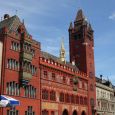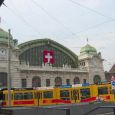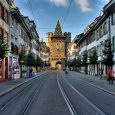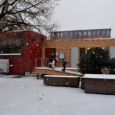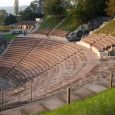Basel
Advertisement
By Air
EuroAirport Basel-Mulhouse-Freiburg is operated jointly by two countries, France and Switzerland. Contrary to popular belief, the airport is located completely on French soil. The airport itself is split into two architecturally independent sectors, one half serving the French side and the other half serving the Swiss side; there was a customs point at the middle of the airport so that people could "emigrate" to the other side of the airport.
By Train
Basel has long held an important place as a rail hub. Three railway stations — those of the German, French and Swiss networks — lie within the city (although the Swiss (Basel SBB) and French (Bâle SNCF) stations are actually in the same complex, separated by Customs and Immigration facilities). Basel Badischer Bahnhof is on the opposite side of the city. Basel's local rail services are supplied by the Basel Regional S-Bahn. The largest goods railway complex of the country[citation needed] is located just outside the city, spanning the municipalities of Muttenz and Pratteln. The new highspeed ICE railway line from Karlsruhe to Basel was completed in 2008 while phase I of the TGV-Est line, opened in June 2007, has reduced travel time from Basel to Paris to 3½ hours.
By Ferries
A somewhat anachronistic yet still widely used system of ferry boats links the two shores. There are four ferries, each situated approximately midway between two bridges. Each is attached by a cable to a block that rides along another cable spanning the river at a height of 20 or 30 metres. To cross the river, the ferryman orients the boat around 45° from the current so that the current pushes the boat across the river. This form of transportation is therefore completely hydraulically driven, requiring no outside energy source.
Historical Museum
In Basle's busy Barfüsserplatz is the 14th C. Barfüsserkirche (church of the barefoot friars), which now houses the Historical Museum, with an important collection on the history of culture and art (renovated 1975-81); cellars constructed and reconstruction of the rood screen). Notable exhibits in the nave of the church are the Late Gothic tapestries and the "Lällenkönig" ("Babbling King"), a crowned head with a movable tongue and eyes, once the emblem of Gross-Basel (17th C.). In the aisles are weapons and furnished rooms, in the choir religious art, in the crypt the Minster treasury.
Town Hall
The Mittlere Brücke leads into the Marktplatz (Market Square), which is dominated by the brightly painted Basle Rathaus (Council House). The main building, with arcades, is in Late Burgundian Gothic style (1504-21); the new wing to the left and the tall tower on the right are 19th C. additions.
The clock is the work of the Master Wilhelms (1511/1512). The wall-paintings in the attractive courtyard are in part the work of Hans Bock (1608-11; restored). The statue (1574) on the outer staircase represents the legendary founder of the town, Munatius Plancus. Visitors can see the two council chambers (the Regierungsratsaal with its impressive wood paneling and the Grossratsaal, which contains 15 coat-of-arms of the Swiss cantons).
Spalentor
To the west of Basle's University is the Spalentor (1370), a fortified gate which marks the end of the old town. The town gate, once part of the old town walls, has stood alone since their destruction in the 19th C. On the left there is an old letter box by M. Berri (1801-1854) with the emblem of the Basle pigeon.
Zoologischer Garten
In the Birsig valley is Basle's large and interesting zoo (Zoologischer Garten; restaurant), affectionately known as the Zolli by the people of Basle. Founded in 1874 with 510 European animals it contains mainly exotic species. It comprises a vivarium (fish, penguins, reptiles), a bear enclosure with different species, an excellent monkey house (1970 orangutans, gorillas, proboscis monkeys, etc.), an aviary (1927) with indigenous and exotic birds, birds of prey, an antelope house and children's zoo. The zoo has been particularly successful in breeding rhinoceros. The elephants put on a performance in a special arena and give rides to children.
Augusta Raurica
A short distance uphill from Augst (signposted) is the site of the Roman colony of Augusta Raurica, founded about 27 B.C., with a large theater and the remains of several temples. At the near end of the site, on the left, is a reconstruction of a Roman house (1953-57) containing a museum. To the right is the theater (restored: performances in summer), and beyond this to the east the site of a temple, the main forum and a basilica. On a hill west of the theater are the remains of a large temple, and to the south a residential district. Southwest of the main complex is an amphitheater discovered in 1959.
Information not available


